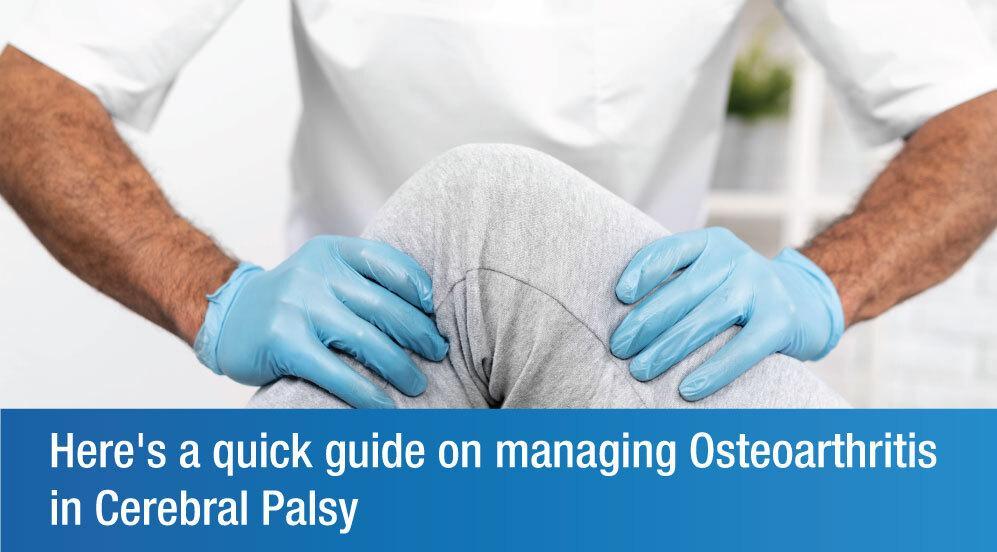
While Cerebral Palsy is a non-degenerative condition (which means that it will not worsen with time), it may lead to secondary disorders that can get worse. For instance, patients with Cerebral Palsy experience joint deterioration in the early stage of their life and are thus at risk for osteoarthritis — a painful condition that requires medical intervention, in addition to the best Cerebral Palsy treatment. Both children and adults are at risk of osteoarthritis, and hence, an understanding of how it manifests is so critical.
Understanding Cerebral Palsy
Cerebral Palsy refers to a group of neurological disorders that affect movement, muscle tone, coordination, and motor skills, caused by damage or abnormalities in the developing brain. Impaired muscle abilities and motor coordination happen as a result of brain damage, in addition to symptoms such as vision problems, poor bladder control, or difficulty speaking. Secondary conditions may also arise as the child grows older.
Why Cerebral Palsy causes Osteoarthritis
Osteoarthritis is the most common type of arthritis and is caused due to degeneration in the joint cartilage. While it is common enough among older people, the musculoskeletal abnormalities that form as a result of Cerebral Palsy lead to overuse and compression of the joints. This results in abnormal movements, which ultimately becomes osteoarthritis. The parts of the body that are at the highest risk for osteoarthritis include:
- Hip: Hip joint arthritis is extremely common among patients with Cerebral Palsy, owing to their often abnormal gait
- Knee: Children struggling to walk may cross the knees while walking, which could lead to wear and tear of the knee joint
- Shoulder/elbow: Muscle imbalances can lead to abnormal movements of the shoulder or elbow joint, causing the cartilage to wear down prematurely
Symptoms of Osteoarthritis
Osteoarthritis manifests as stiffness and pain in the joints of the body, including the shoulders, knees, hips, knuckles, and elbows. While many patients with Cerebral Palsy do not experience Osteoarthritis until adulthood, some children may also get it. Hence, parents should keep an eye out for certain symptoms including:
- Stiffness in the joint after sleeping or inactivity
- Pain in the joint during or after any movement
- Inability to flex the joint through a full range of motion
- Tenderness when the joint is touched
- A grating feeling inside a joint when moved
- Hard lumps under the skin surrounding a joint
Tips on managing Osteoarthritis as a patient with Cerebral Palsy
Treatment for Cerebral Palsy typically includes a combination of Stem Cell Therapy, Occupational Therapy, Speech and Language Therapy, and Physiotherapy. Treatment of any musculoskeletal abnormalities can help reduce damage to the joints and minimize the effects of osteoarthritis. Besides, the following self-care tips can also help you to manage the condition better and reduce the pain you experience on a day-to-day basis.
- Ask your physiotherapist for gentle exercises to work specific muscles and thus, make it easier to move specific joints
- Exercises that specifically assist with balance training can help prevent stumbles and falls. Yoga, tai chi, and balancing on wobble boards are all good options
- Over-the-counter pain medication can help alleviate the symptoms on a day-to-day basis. However, be sure to not take too many of them
- If your osteoarthritis is in the hips or knees, consider losing some weight based on a health plan that your physician prescribes
- Use ice packs if you have injured or swollen muscles or joints. Heat packs are a good option for relieving painful joints
- If you can afford it, hire a personal care attendant to escort you wherever you need to go. You can also ask a friend or family member to accompany you if you are not confident about going somewhere alone
- If you feel unstable walking because of misaligned joints, talk to your physician about investing in a leg brace or cane to move about safely
- Don’t let the pain become the biggest part of your life. Take charge of how you are feeling and get help whenever you feel like you need it
Osteoarthritis is one of the most common secondary conditions that patients with Cerebral Palsy often face, and avoiding it completely may not be possible. However, the sooner a patient gets the right diagnosis and starts benefitting from the best Cerebral Palsy treatment, the sooner they can begin working on strengthening their muscles and joints.










